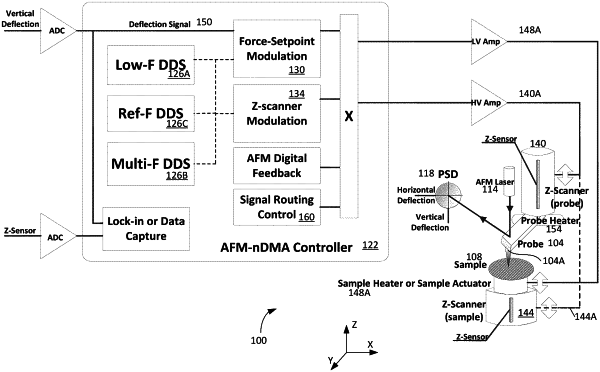| CPC G01Q 60/38 (2013.01) [G01Q 10/04 (2013.01); G01Q 20/04 (2013.01); G01Q 30/04 (2013.01); B82Y 35/00 (2013.01)] | 20 Claims |

|
1. An apparatus configured to determine a mechanical property of a viscoelastic sample with an atomic-force-microscope (AFM) hardware, the apparatus comprising:
an excitation electronic circuitry operably connected with the AFM and configured to generate an excitation force signal that includes a fundamental signal at a fundamental frequency and multiple harmonic signals at corresponding multiple harmonics of the fundamental frequency, wherein
(a) said fundamental signal and said multiple harmonic signals have no pre-determined phase shifts with respect to one another such that the excitation force signal has a maximum excitation force value only at a beginning of a pre-determined time period and a minimum excitation force value only at an end of said pre-determinedtime period, or
b) said fundamental signal and said multiple harmonic signals have pre-determined phase shifts with respect to one another such that the excitation force signal includes multiple amplitude peaks within said pre-determined time period;
a feedback electronic circuitry configured to monitor both a mean value of said excitation force signal and an oscillatory component of said excitation force signal and to generate a feedback output representing both the mean value of said excitation force signal and the oscillatory component of said excitation force signal;
an electro-mechanical sub-system cooperated with the excitation electronic circuitry and the feedback electronic circuitry and configured:
when the cantilever is deflected by a pre-determined amount from a nominal orientation thereof, as determined by a position-detecting system of the apparatus, to cause a mechanical oscillation between the sample and the probe in response to the excitation force signal transferred from the excitation electronic circuitry; and
upon receiving the feedback output, to maintain one of the sample and the probe in a position, with respect to the other of the sample and the probe, in which at least one of
i) an average sample-loading force, generated by the probe, and
ii) an area of contact between a tip of the probe and a surface of the sample
is kept substantially constant during said mechanical oscillation; and
a programmable processor in operable communication with at least the position-detecting system and programmed:
to transfer the excitation force signal from the excitation electronic circuitry to the electro-mechanical sub-system, and
to suspend an operation of the electro-mechanical sub-system for a relaxation period of time sufficient for relaxation of a creep of the surface of the sample that is caused by repositioning of said one of the sample and the probe with respect to the other of the sample and the probe.
|